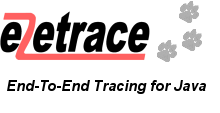
I developed e2etrace originally as an example for my book "Konfigurationsmanagement mit Subversion, Maven und Redmine" (see http://www.km-buch.de). As you might have guessed, the book is in German. The english title would probably be "Configuration Management using Subversion, Maven and Redmine". The book describes a pragmatic CM approach using open source tools. When I decided to write the book, I was in need of an example application to demonstrate tasks like developing the project structure, managing files using Subversion, planning and performing releases and creating developer, integration and release build scripts. Since I dislike writing useless code and I've been missing "real" tracing in Java functionality for years, I decided to finally jump at the chance and created e2etrace.
In my first two editions of the book I implemented the build process for e2etrace in two variants: one using Ant and a second one using Maven. This gave the readers the opportunity to compare the functionality of both tools by their own. For the public release of e2etrace I decided to keep only the Maven build process. This is mainly due to the fact that I personally think Maven is the better tool for the job. Since the 3rd edition of the book I removed the Ant chapter and replaced it with a new one covering Redmine (http://www.redmine.org).
Logging and tracing are two entirely different problem domains. You should use logging intensively in your applications to ease debugging and monitor errors. However, in my experience it is not very efficient to use logging functionality to trace the execution steps of your system. You don't need a zillion of isolated trace messages in one giant log file, but a trace tree that maintains the hierarchical call structure of your system. e2etrace is able to create this trace tree from the single execution steps of your application (to learn more, take a look at the functional overview). So, just keep your favourite logging framework and use e2etrace additionally for the tracing stuff.